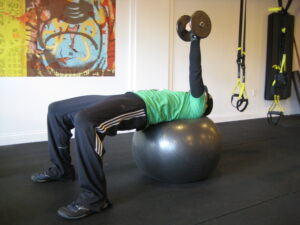Swiss Ball workouts for golf have many functional advantages over the machines you will find in most commercial gyms.
Also known as a “Physio-Ball”, Swiss Balls were originally used in the rehabilitative setting throughout Europe. Paul Chek was among the first in the US to incorporate them into healthy and athletic populations.
There are a couple of reasons why you should have a Swiss Ball and incorporate it into your golf workouts:
1) It is a perfect piece of equipment for the home gym, as it can replace a bench and several exercise machines (more on that in a moment).
2) It provides an “unstable” training environment, which engages more muscles, especially the core and low back.
3) Enhances spinal and peripheral joint stability, which has been shown to reduce risk of injury in athletes.
4) Provides high levels of nervous system activation, which can mean that the coordination and strength that you gain can be more easily transferred over to the golf course.
Choosing your Swiss Ball
Swiss Balls range is size from 45 cm to 75 cm.
Follow the height chart below to choose the proper size:
Under 5’2″ – 45cm Swiss Ball
5’3″ – 5’8″ – 55cm Swiss Ball
5’9″ – 6’2″ – 65cm Swiss Ball
Above 6’3″ – 75cm Swiss Ball
Exercise Examples for a Swiss Ball
The main advantage of using a Swiss Ball instead of a fixed machine is that you are forced to balance and control the ball, which engages more muscles and trains your central nervous system.
For example, instead of doing a machine chest press, you could use a Swiss Ball. This forces your legs, glutes, low back and core to all be activated, and challenges your balance:


You could also replace the traditional leg curl machine with a supine version on the Swiss Ball:


A Swiss Ball can be used to “descend” an exercise (make it slightly easier). For example, many of our senior golfers will start with a Swiss Ball Wall Squat, until they build up some strength to advance to a free-standing version:


And then there are some Swiss Ball exercises that are unique, like the Swiss Ball Prone Jackknife:


When to use a Swiss Ball
You can take advantage of Swiss Ball training during the stability and balance phases of your program. They would not factor in much during your strength or power phases, as those exercises are better done on a stable surface for maximum benefit.
How NOT to use a Swiss Ball
Like all things in life and golf fitness training, you can have too much of a good thing.
Although popular in some training circles, I would NOT recommend the practice of standing on a Swiss Ball, as Dustin Johnson is doing in the photo at the top of this post.
Impressive… sure.
But I always keep in mind the risk/reward ratio in choosing exercises.
And the reward with this “stunt” is really quite minimal when you consider the cross-over to golf (or lack-thereof). Kneeling on a Swiss Ball is a much safer version, and would have nearly the same benefits.
The risk of the standing version is way too high… think about a million dollar athlete falling off the ball and spraining an ankle, then sitting out of competition for a month or more (it has happened – Vijay Singh).
To be fair, that particular issue of Golf Digest had some very solid golf fitness training info… they no doubt used that photo of Dustin because it’s dramatic, and get readers to take a look… the same reason I used it 😉
If you enjoyed this post, then join 13, 134 other golfers and get free email updates >>> Click Here<<<
